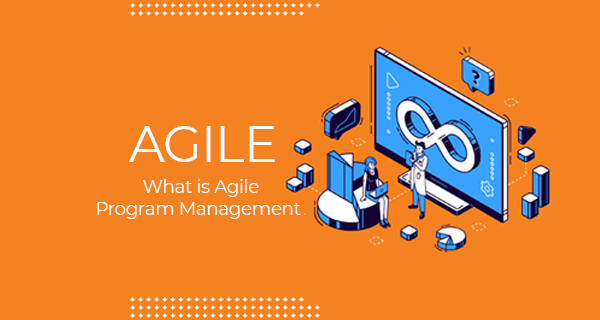What is Agile Program Management?

What is Agile Program Management?
Agile program management applies principles and values of agile in the administration, organization, and execution of programs that encompass various activities, initiatives, products, and services.
It started by adopting the values and the principles laid out in the Agile Manifesto and applying them to a wider range of projects than their initial scope of application to software development.
The point at which it gets interesting is the moment:
- It is possible to bundle similar products into the program.
- You want to apply agile principles and values in large-scale programs that involve multi-disciplinary teams.
- Many programs in your arsenal must be integrated to achieve results.
- You implement programs that make an entire business agile, such as Software development, DevOps, human marketing resources, and all business activities.
Companies are discovering that it is more beneficial to implement Agile Program Management (sometimes called in a broad context agile portfolio administration) to improve the performance of every department’s programs, products, and departments. This is not only to create an overview of how an organization is doing overall but also to link the enterprise’s operations with its strategic goals and make the entire business agile.
What does adopting an Agile Program Management mean for your business?
What does this all mean in real life? It’s about making changes to everything you do to organize your work. This includes:
- Plan in smaller increments rather than the “big up front planning” method.
- Rapid changes in the strategic direction and the results of programs depend on circumstances in the marketplace and customer feedback.
- Decentralizing decisions.
- Creating transparency and alignment around your strategic goals and the way you manage your work.
- Finding the right equilibrium between autonomous teams and cross-team dependence.
- Delivering faster and perfecting products in small increments.
- Working with the various teams that are working on a project and other experts in your organization, and also with your clients.
- Integrating, updating, and replacing your information systems to ensure the flow of information is transparent across your organization.
Despite the mountain of work, when you utilize flexible methods for managing programs is easier to apply the company’s strategic plans across all its departments, programs, and other products. It’s not always straightforward, but it’s certainly the most efficient route to the transformation of your company.
Read more: Agile Planning: A Beginner’s Guide To Planning Projects
Agile Program Management Governance
Achieving agile program management is grounded in solid governance. This is typically performed by the PMO and includes:
- The development of standards, structures, and procedures for regulating the operation.
- The choice of metrics and KPIs is to track and manage the performance.
- Ensuring that every program is in line with the organization’s priorities.
- Allocating resources (people, technology, equipment, etc.) to optimize performance.
- Financial management is the process of ensuring the feasibility of the program and its profit.
- Implementing best practices across all programs (more about this in the following).
Best Practices in Agile Program Management
There isn’t a “one-size-fits-all” method for the management of agile projects. In certain organizations, it is the management of several agile projects (also called “the scrum of scrums”). In other organizations, it’s described as incorporating agile processes (e.g., weekly stand-ups) within a traditional management model for programs.
But, regardless of the nature of the project, there are essential best practices that every organization and team must adopt. These include:
- Create a standardized, consistent, reliable, and repeatable system that provides the best value to clients. The process should be as straightforward and efficient as possible.
- Implement an adaptive approach to development that drives continuous results that can be easily assessed and analyzed.
- Be aware of the importance of having well-equipped, empowered, and engaged teams that are equipped, empowered, and engaged. By not doing this, you can create tired team members who regularly delay deadlines, deliver poor quality work, block or bypass feedback loops and wander the halls as if they were zombies (if this has already been taking place in your workplace, This is the way you can do to stop it).
- Utilize sophisticated yet simple-to-use programs management tools that improve instead of. Hinders performance. This software should work with existing tools within the system, be extremely adaptable and flexible, limit the chance of duplicate work, and encourage collaboration between internal and external sources.
Agile Program Management vs. Traditional Program Management
Agile program management focuses on providing business value to all participants, e.g., employees, contractors, shareholders, employees, and the business’s customers. The objective is to offer an answer that addresses the customer’s problem.
Traditional program management is centered on agreeing on what needs to be delivered and then effectively delivering it at the exact time.
Both break the work into smaller pieces, making it easier to monitor the progress. The main difference is how work is divided.
Agile strives to create value from the beginning and build on what’s already been done and proved to be worth it. The work is broken down into smaller, independent, and testable units that can provide the customer with value independently.
Traditional’s emphasis on efficiency means the work is broken down to improve efficiency. This can delay the delivery of any goods until the entire work is completed.
Due to the way agile program management reduces work, it can react to any changes that occur. The work you’ve already completed is producing value, even though you’d prefer to change it. You are always free to choose the next steps to take -altering work that has already been completed or moving on to the work that needs to be completed following the value to your business you’d like from it.
This contrasts with the traditional approach to the management of programs. Dislikes changes and will go to any measures to prevent them.
Since the breakdown of work is geared toward efficiency, any changes to the plan that was initially agreed on usually render the work that was already completed obsolete or required redoing, which increases the program’s costs and timeframe and causes the product(s) the delivery of value is delayed as well.
Agile Program Management Principles
There are three core concepts of agile program management: focus on the customer’s value, fostering continuous changes, and creating efficient collaboration. Each of these principles will be briefly explained in the following paragraphs.
Fostering Constant Change
Traditional project management is prone to employ a waterfall strategy that involves teams working in stages towards a larger “launch.” If the plan is delayed during one phase and causes delays in the next, it can cause further delays. If the project becomes stalled because of changing demands, the project will stall until a resolution can be reached. This strategy does not account for the possibility of change, and consequently, the idea of change is seen as a negative force.
When it comes to Agile Program Management, the objective isn’t to deliver as scheduled but rather to provide what the client wants. Teams adopt an incremental development approach by establishing regular feedback intervals and accepting any changes that improve the value they can provide. Developing in iterations ensures that teams can adapt quickly, keep moving ahead as the conditions change, and integrate feedback from customers in real-time as needs change.
Establishing Effective Collaboration
If the focus is on completing boxes and moving forward, teams aren’t enticed to work together instead of creating customer value. With Agile Program Management, teams can reap the benefits of collaboration with other teams as they are dependent on each other to reach the common aim of maximizing the value of customers. Agile teams function as an interconnected, ever-changing system where all stakeholders are active in both creation and delivery.
Concentrating on Customer Value
Agile Program Management fundamentally changes the way success or value is assessed. When it comes to traditional management of projects, the definition of value is reliability and efficiency: Being capable of swiftly and reliably completing the task we started we’d deliver.
When it comes to Agile Program Management, it’s described as being responsive: Being in a position to provide the services customers desire and need when they desire and require them. Providing value in a timely and reliable manner is crucial, but it’s less important than delivering value. In other words, agile companies strive to increase their responsiveness to be more reliable and efficient for their clients.
The Role of Agile Program Management
Learning to practice Agile Program Management efficiently requires the participation of various key positions, including product managers, system architects/ engineers, Release Train Engineers (RTE), and business owners.
Production Management
When it comes to Agile program management, the product manager serves as a crucial intermediary between internal stakeholders and teams of developers. The main goal of a Product Manager is to define and modify the roadmap for the product and a plan of the way a solution or product will evolve. Also, they try to answer the question, “What is next?”
Product managers are responsible for maintaining the roadmap of the product in line with present market conditions and future objectives: deciding on what features to develop, when, and how to organize the development of different features to increase the development capabilities and satisfy the needs of customers.
To be able to fulfill their duties effectively. The majority of their work is asking questions with a thoughtful approach to synthesis, analyzing information, and coordinating to ensure the alignment of the various groups.
Systems Architect / Engineering
System engineers/architects are in charge of defining the design vision of the Agile Release Train (ART). They serve as the technical leaders of the ART in ensuring that the solution being created is appropriate for its function and is designed according to the larger technology and abilities. The job of product management is to decide, “What should we do next?” system architect engineers are responsible for: “How can we do it?”
In Agile Program Management, system architects/ engineers play an essential part in bringing teams together to an agreed vision and direction in the technical field. They collaborate with Agile team members to
- Explain the technical background and purpose of each program.
- Examine the trade-offs between technical and non-technical aspects
- Determine the principal subsystems and components involved
- Define non-functional requirements (such as reliability, security, maintainability, and scalability.)
- Assist various internal and externe organizations in ensuring that you are fit for the job.
Release Train Engineers (RTEs)
Release Train Engineers, also known as RTEs, are Agile teams’ top leaders and coaches. As part of Agile Program Management, RTEs perform crucial roles in the facilitation of the ART processes and events, such as PI (Program Increment) planning and IP (Innovation & Planning) iterations, and I&A (Inspect & Adapt) events.
In companies that do not employ the SAFe method of scaling Agile. The person in charge of this position will be referred to as the Program Manager. RTEs and Program Managers are also accountable for ensuring that Agile teams deliver value as expected. This includes communicating with external and internal stakeholders, escalating obstacles, encouraging continuous improvement, and assisting with managing risks.
Businesses Owners
Business owners are accountable for the value-added and the return on investment of the Agile Release Train. They are typically responsible for the company that the ART role plays and the stream of value.
When using Agile program management, the business owners make sure the ART(s) delivers the value they have set to meet goals and results. By bringing changes and pivots to the forefront during Lean Portfolio Management meetings or Delivery Steering meetings, Business Owners keep priorities aligned with the most crucial business objectives.
Frameworks, Methods Techniques, Practices, and tools
Frameworks and methods
Many frameworks and techniques assist an enterprise’s inflexible program management. A few of them include:
- Portfolio Kanban is a way to extend the beloved Kanban visualization tool for portfolio and program management.
- Scaled Agile Framework (SAFe): is an adapted agile framework used with teams, programs, and portfolios.
- Disciplined Agile (DA): offers a framework that helps companies handle various tasks in an agile way, allowing them to become a Disciplined Agile enterprise.
- Scrum@Scale (SaS): offers the scrum master cycle as well as a cycle of product owners that both aim to tie the product development process to the company’s strategic plan.
- Large Scale Scrum (LeSS) and LeSS Huge: are scrums written large. They offer frameworks for implementing and implementing agile at scale based on business size.
- Nexus: is a third scrum-based framework that aims to simplify and reduce dependencies to facilitate scaling.
Read more: Agile methodology: Definition, Phases and Types
Tools
A simple system that can identify information and monitor results is crucial in managing programs.
Kanban and other tools for agile that connect the strategic portfolio/program goals to the day-to-day work of teams can help them identify barriers and dependencies hindering the flow of the product and the value it provides to customers.
The Benefits of Leveraging the Correct technology for agile program management
Ensuring you have the right tools in your arsenal to help enable Agile Programming Management is crucial to success when scaling Agile. It is important not to disrupt the existing process by making everyone adopt new software.
In the ideal scenario, you will choose an application that is compatible with the existing tools that your teams are currently using to make the data that comes from these tools valuable and accessible to the rest of the company. Many Agile companies use enterprise Kanban tools to connect all the tools they have in their stack, creating one common overview of the work shared by the entire Agile team. It is equally crucial to choose highly adjustable tools so that they can be adapted to accurately reflect your company’s specific processes and support the planning of PI events, for example.
The most appropriate Agile tools can allow Agile organizations to manage work across teams of teams to cut down on rework and wasted time and effort. They can also assist teams in organizing and understanding dependencies and obstacles, which will allow teams to avoid issues that could lead them off-track and result in waste.
If there is no way to comprehend how value is being transferred through an Agile organization, it isn’t easy to establish a case for the funding of Agile teams. The most efficient technology can provide business owners with understanding and confidence that their ARTs are doing the correct job at the right moment to make sure that they are successful in the Agile initiatives.
Common Pitfalls
Here are a few most common mistakes you can make when transforming your business into agile methods of working:
- Instituting changes rather than helping departments and teams on their path to agility. Making changes is rarely successful and can lead to the resistance to change myth. People transform in a flash when they realize that things are fun (Pokemon Go got the biggest couch potato on their feet) or work for their benefit.
- The idea is that training is sufficient. Agile is a mentality and a set of practices. Changes in your habits and mindset take a lot of time and effort. It’s not going to happen because you’d like it to. You’ll need a lot of focus and effort, and reinforcement to keep it going.
- Maintaining layers of management that reduce the benefits of agile and flexible management. Remove the layers of management that you don’t need, and assist them in finding an alternative role or purpose to prevent ineffective resistance.
- Remaining with old reward and reporting systems (promotion or salary increases and perks, etc.) that encourage employees to work towards local goals. Make them more flexible to encourage the behavior that you’d like to observe.
- Lack of training. In the absence of adequate training for all involved in your agile path, You’ll soon be reaping the wrath of people who interpret things differently. Everyone should be on the same page, and the simplest way to do this is to ensure that everyone is taught the same way about the basics.
- Lack of coaching. Training is important, but it’s not enough. The new knowledge must be “inserted” before anyone can apply it as a “second nature”. Coaches are crucial to keep the training going, recognize progress, and spot the inevitable slip-ups back into old practices before they become habitual.
- Uncertainty due to not getting all departments to join. It’s possible to run a few pilots or even phase out the agile rolling out since you cannot manage everything at one at the same time. Be aware that any department that continues to work traditionally could significantly impact the progress you make. The first step is to get everyone up to speed with your goals and perhaps assign some people from these departments to assist in the agile journey. The pioneers will offer a wealth of experience when the entire department embarks on its agile journey.
- Do not worry too over the standardization process. Only make sure you standardize the most important aspects, the following: your KPIs and the way everybody is reporting on them. Let the teams determine their methodology and tools as long as they can (automatically) integrate the analytics and reporting you’re using.
- Dependencies between departments and teams. Try to reduce dependence by managing work and shifting the responsibilities to allow teams to move forward without waiting for the results of other departments or teams.
- Lack of acceptance for agile ideas at the highest level can lead to misalignments across the company, resulting in several of the issues mentioned earlier.
The Bottom Line
Instead of a methodology, agile program management is a mentality. As a result, what works in one business, market, or industry could not work in another. What matters most is that resources and infrastructure are optimized, meaningful and measurable customer value is delivered, and corporate goals are met profitably.



